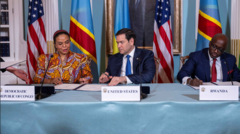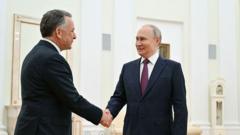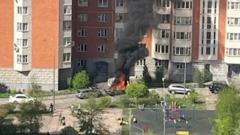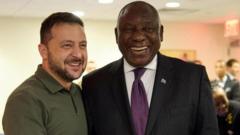Ukraine is drafting a new peace proposal in response to a U.S. plan that critics argue would favor Russia. The proposal includes key provisions such as military autonomy for Ukraine and a U.S.-backed security contingent. However, it notably leaves room for compromise on territorial and NATO issues.
Ukraine Proposes New Peace Plan Amid Ongoing Conflict with Russia

Ukraine Proposes New Peace Plan Amid Ongoing Conflict with Russia
In the wake of a controversial U.S. peace proposal, Ukraine's government presents a counteroffer that hints at possible concessions despite significant obstacles.
In response to a controversial proposal from the White House aimed at resolving the ongoing conflict in Ukraine, the Ukrainian government has developed an alternative peace plan. This new strategy appears to break with some of the previously steadfast positions of Ukraine’s leadership, potentially paving the way for negotiations. President Volodymyr Zelensky rejects the U.S. plan, which critics argue would cede significant ground to the Kremlin.
Details of the Ukrainian proposal, shared with The New York Times, indicate a desire for no military restrictions on Ukraine, the establishment of a U.S.-supported European security presence on its soil, and the utilization of frozen Russian assets to aid in rebuilding the war-torn nation. While these elements might be unacceptable to Moscow, the proposal suggests a willingness to explore compromises on issues that have been historically pivotal — such as reclaiming all territory occupied by Russia and NATO membership aspirations.
As discussions unfold, U.S. President Trump expressed optimism regarding a potential resolution, indicating that both nations are nearing a deal. He suggested that direct talks between the two sides would be beneficial, and expressed hope for a meeting with Zelensky during a visit to Rome, where both leaders were expected to attend the funeral of Pope Francis.
Zelensky’s tone indicates a cautiously optimistic outlook, hinting at "very significant meetings" that could move Ukraine toward a more peaceful state. The Ukrainian President’s willingness to engage further in diplomatic channels reflects an evolving landscape in the negotiation dynamics of the conflict, but considerable challenges remain in reconciling the ambitions of both Kyiv and Moscow in the ongoing war.
Details of the Ukrainian proposal, shared with The New York Times, indicate a desire for no military restrictions on Ukraine, the establishment of a U.S.-supported European security presence on its soil, and the utilization of frozen Russian assets to aid in rebuilding the war-torn nation. While these elements might be unacceptable to Moscow, the proposal suggests a willingness to explore compromises on issues that have been historically pivotal — such as reclaiming all territory occupied by Russia and NATO membership aspirations.
As discussions unfold, U.S. President Trump expressed optimism regarding a potential resolution, indicating that both nations are nearing a deal. He suggested that direct talks between the two sides would be beneficial, and expressed hope for a meeting with Zelensky during a visit to Rome, where both leaders were expected to attend the funeral of Pope Francis.
Zelensky’s tone indicates a cautiously optimistic outlook, hinting at "very significant meetings" that could move Ukraine toward a more peaceful state. The Ukrainian President’s willingness to engage further in diplomatic channels reflects an evolving landscape in the negotiation dynamics of the conflict, but considerable challenges remain in reconciling the ambitions of both Kyiv and Moscow in the ongoing war.






















